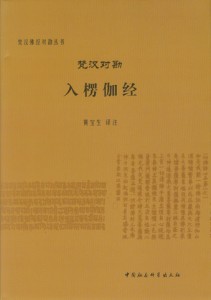 Someone please tell me that this isn’t simply the CBETA e-text pasted alongside the DSBC e-text, printed out and slapped between a cover? Even priced at 88 Yuan (currently less than USD$14), that would be still worth less than the paper it’s printed on:
Someone please tell me that this isn’t simply the CBETA e-text pasted alongside the DSBC e-text, printed out and slapped between a cover? Even priced at 88 Yuan (currently less than USD$14), that would be still worth less than the paper it’s printed on:
黄宝生(译注/作者) 《梵汉对勘入楞伽经》 中国社会科学出版社 ISBN 9787500496267 88.00元 600千字
Huang, Baosheng. Fàn-Hàn duì kān Rù léngjiā jīng [Sanskrit-Chinese* collation of the Laṅkāvatāra-sūtra]. Beijing: China Social Sciences Press, 2011. 765 pp. [official site]
* The “Tang-era translation” (唐代譯).
The same publisher has put out a similar treatment of the Bodhicaryāvatāra, apparently. STOP PRESS: and the Vimalakīrtinirdeśa (I guess they are using GRETIL’s ‘unofficial’ e-text).
Frankly speaking — I know that’s what brings some of you here — one rarely, if ever, sees this kind of thing in Japan. Right?


Haven’t seen this yet. The Bodhicaryāvatāra from the same source was done with some care, though it certainly cannot be judged a significant scholarly contribution. It seemed to be aimed mainly, perhaps, at Chinese Sanskrit students, as aids for them in self-study (see also the anthology published under the same editorship a few years ago).
With the LAS the Sanskrit text is so problematic in all published editions that it seems not very well suited to such a thing. But I shall refrain from judging it till I see it.
H.I.
This is my question: what Sanskrit text are they using? I don’t expect them to create a new edition from scratch, but since improvements have been proposed since Nanjio, there is no reason for them not to adopt at least some of those. For instance, Takasaki’s 1981 edition of one chapter looks like an improvement to me; though it might be less than ideal, I’m not sure I would characterise it as problematic.
>For instance, Takasaki’s 1981 edition of one chapter looks like an >improvement to me; though it might be less than ideal, I’m not sure I would >characterise it as problematic.
I agree that Takasaki’s edition of the Kṣaṇikaparivarta is a considerable improvement over Nanjio’s; and as you say, others too have proposed improvements. Note that I called not the editions problematic, but their text (I had in mind the text of the complete editions, rather than of partial editions such as Takasaki’s, though I am afraid that the adjective can still be applied even to that of his).
Even careful editions may not be able to establish a text that is unproblematic, if a work has been transmitted poorly, for instance. In my opinion the transmission of the LAS is very complex, and the MSS used till now (also by Takasaki) not very good. We will have to wait still for an edition of the whole Sūtra that, availing itself of better manuscript material (which I believe to be extant), and making careful use of Chinese and Tibetan material (including commentaries) and the testimony of citations, establishes a better text and gives us substantive commentary on the many textual problems.
H.I.